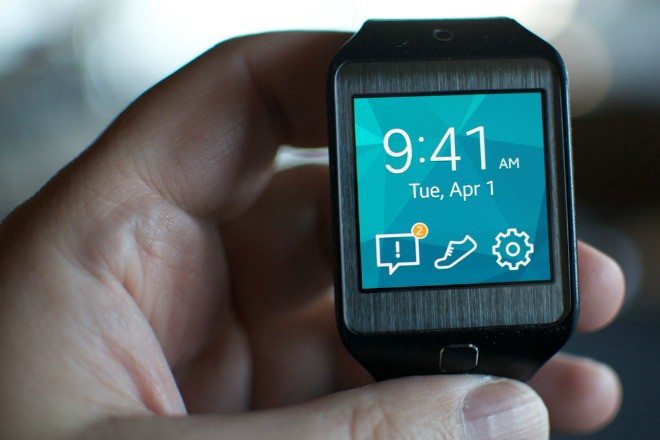While new wearable hardware might be getting all the media attention, Forrester indicates that wearable apps are the key to helping companies create a connection with their customers and the ability to analyze big data generated from wearables. According to a Forrester analyst, “these wearable devices will fail to be effective and people will toss them aside if there isn’t a good service layer that goes with them.”
If you’re reading this article, you represent the few visionaries in marketing and product strategy who grasp the potential of smart wearable computing and intuitively understand how it will transform the way we work, play and interact with the world around us. You’ve read the stats on venture-backed capital flowing into wearables and the hard dollars being invested by Samsung, Google, Apple, Intel, Facebook (Oculus for $2 billion) and other tech giants. So you don’t need to be convinced that smart wearables represent a tectonic shift in computing paradigm. What you’re pondering is how can your company enter this nascent market in the most sagacious manner. What are the best practices that you and your executive cohort can use to rationalize how your company can go about developing wearable apps.
Here’s a practical framework for wearable use case development that will help crystallize your wearable app strategy:
Avoid Building on Dumb Sensors
Overinvesting in early hardware could make your wearable app development obsolete even before it’s launched. Many of today’s so called wearables are “dumb” sensor-laden devices (SLDs). As Owen Thomas rightly comments glorified pedometer like that of Nike Fuelband must die. In years to come, these rudimentary fitness and health SLD’s will become obsolete as nanomaterials and nanosensorsare integrated into our bodies, clothing, handbags, jewelry, belts, hats, seats and other inanimate objects around us. The MJ Bale Power Suit for contactless payments with Visa’s payWave exemplifies how NFC chip and transmitter can be integrated into the sleeve of the suit near the wrist, eliminating the need to carry a bulky wallet or take out a smartphone for purchases.
The notion of connected intelligence indicates that wearable devices must go beyond simply sensing, connecting and reporting. Smart wearable devices need to be able to process data independently and be more than a remote sensor, but an intelligent node with sensing, connectivity and embedded processing.
Hence, if you are thinking about building a wearable app, make sure that it’s based on an intelligent node that has the potential to become a full-fledged computing system.
Develop to Learn, Not to Perfect
Evernote CEO Phil Libin acknowledges that it’s far too early to pick a winner, or to pretend that anything they’re doing now will look at all like finished products available to a mature wearables market.
Phil warns companies about taking a wait-and-see approach. If they do, he says “you risk being left behind… I think you’re going to see companies flaming out left and right that just ignored this, and that just focus on what they have been focusing on and are then completely unprepared for this new world.” Libin recognizes that experimentation is not optional if they want to stay relevant. Evernote is developing apps for Android Wear, Pebble, Google Glass, Samsung Gear and other smart wearable devices.
For your organization, it may not make sense to have a wearable app on every smart wearable hardware. Rather the point is that wearable app development needs to be understood by internal stakeholders that it’s an iterative process to build on fresh insights gained with each development cycle. Moreover, hardware and operating system (OS) advancements will require your app to be updated to leverage new features and functions.
Don’t Let the Hardware Drive the Use Cases
Don’t make the mistake of falling into the herd mentality. It may be tempting to announce that your company is going to build a Google Glass app because Glass is at the forefront of media attention. Their general release product is not likely to cover all possible use cases for an immersive augmented reality (AR) experience. So before settling on a device, let your business use case drive the design process.
As you vet out the use cases, the reality of what’s not possible will undoubtedly come into the picture but starting with a hardware-driven approach will kill your creativity even before you put your thinking cap on; you will be handicapped from the onset. Rather, start with a persona and what is it that s/he is trying to accomplish through your wearable app.
For illustrative purposes, let’s say that you need to present a compelling business case on why your firm should pursue a wearable app to your executive steering committee. In this example, the need to create desktop quality presentation becomes your wearable use case. (This notion of using wearables for productivity is not too far off as we migrate from PCs to tablets and eventually to wearables. Office for iPad apps reached 27 million downloads in 46 days.)
Before prematurely constraining yourself with what you can’t or can do with the current wearables, do some creative thinking.
Sometimes you do your best work not in front of a desktop but doodling on a whiteboard. In the current state, after sketching out your masterpiece on the whiteboard, you take a photo and then use it as a reference to manually recreate your presentation on PowerPoint. What you really want is the ability to do it once with precision. What if you could have a virtual whiteboard via augmented reality projected unto your office wall and then using hand gestures write and draw diagrams to communicate your concepts on the virtual canvas?
Once you finish your doodling, you want your scribbles to convert to sharp, readable text and your lopsided diagrams to convert into SmartArt Graphics to convey your concepts professionally. For more precision formatting, you can do everything that you would do in PowerPoint but using your fingers to drag and drop, stretch, resize and change formatting attributes. Voilà, your work of art is finished, ready for primetime. After running spell and grammar check, you upload the virtual presentation to your enterprise cloud or email to a few stakeholders to give them a preview before the big meeting next week.
Map the Use Case to Wearable Devices for Fit Assessment
Formulate questions relevant for the wearable context and allow the use case to determine the best available wearable hardware for the job.
Continuing the use case example from above, are smartglasses the right metaphor? Would that be cumbersome for people in an office setting? Would people prefer to interact with a finger-mounted, input device? Would they be more comfortable doing things while sitting or standing? How would people move to create an AR presentation?
After much deliberation, you might narrow your choices to AR smartglasses such as MetaPro or gesture-control devices such as the Ring and Nod. Of course, a ring-based input device, much like a Wii controller, does not replace the need for a big screen or PC; it’s just replaces the physical keyboard and mouse.
Partner With Device Makers to Shape their Product Roadmap
Hardware and software has a symbiotic relationship. You can’t build your killer app if the hardware and wearable OS does not support the needed functionality. Likewise, device makers need to interact with device users to understand what capabilities are required. So after you’ve narrowed down the top wearable hardwares, reach out to those wearable device manufacturers to see if they’re open to collaborating with you. Real life use cases will be viewed enormously valuable to these hardware firms.
Take MetaPro, for instance, they are dying to understand compelling use cases for their smartglasses as evidenced by their Submit App Ideas page. Rather than anecdotal and half-baked suggestions from random people, you can bring to them real-life use cases that they can sink their teeth into.
OS standards and capabilities may be a bit more trickier to influence as a single firm but through the developer community for Android Wear, Tizen and iOS, you can find a voice.
Do It Again
Set a realistic expectation with your internal champions that this is not a one-time project but a continuous commitment to iterate. As wearable computing systems and OS advance, your wearable app needs to be extended to take advantage of new capabilities.
The worse mistake would be inaction. Just ask Microsoft and Intel (in regards to mobile).
Originally published on Wired on May 15, 2014. Author Scott Amyx.


















